Showing all 36 results
-
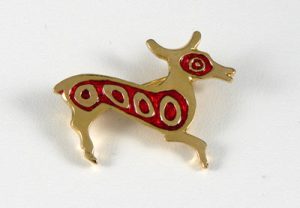
Animal Brooch
£32.75Roman women were very fond of small animal or bird brooches cast in bronze and delicately enamelled in a variety of colours. Several examples have been found at sites of Roman occupation. Length 30mm
-
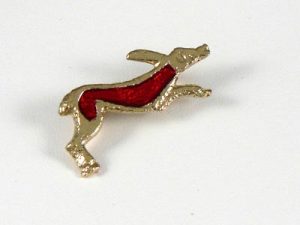
Animal Brooch
£31.50Roman women were very fond of small animal or bird brooches cast in bronze and delicately enamelled in a variety of colours. Several examples have been found at sites of Roman occupation. Length 30mm
-
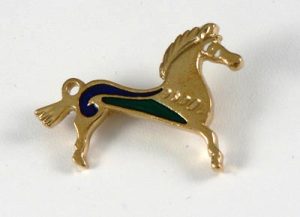
Animal Brooch
£33.00Roman women were very fond of small animal or bird brooches cast in bronze and delicately enamelled in a variety of colours. Several examples have been found at sites of Roman occupation. Length 36mm
-
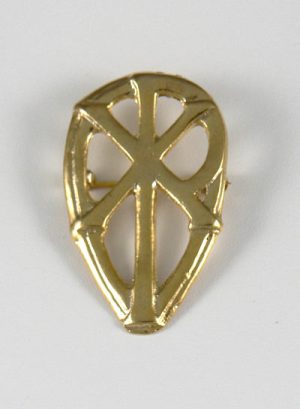
Chi Rho Brooch
£30.00Detail taken from a bronze pew decoration in the parish church at Dodington House, Gloucester. It is the family seat of Major Codrington. The Greek monogram Chi Rho is composed of the first two letters of the Greek word XPICTOC, meaning Christ. Height 46mm
-
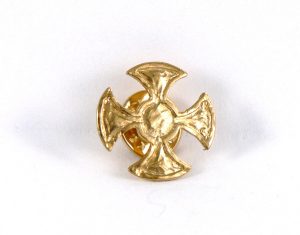
Consecration Cross
£22.14Romano-British Consecration Cross. The original cross dates from the foundation of St. Peter Monkwearmouth in AD 674 by St. Benedict Biscop. Monkwearmouth, Tyne and Wear. Reproduced as a lapel pin. Diameter 20mm.
-
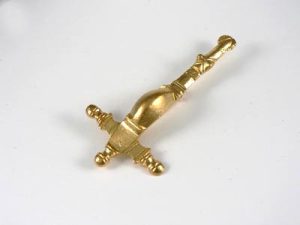
Cruciform Brooch
£29.85Cruciform Brooch. 5th century AD. The bronze original was found outside a house of the Roman Iron Age during excavations at Marslev, North East Funen. Odense Bys Museer, Denmark. Gilded pewter. Height 66mm
-
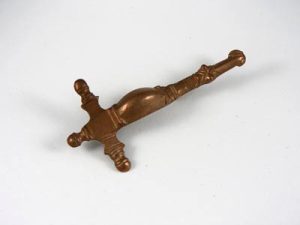
Cruciform Brooch
£37.50Cruciform Brooch. 5th century AD. The bronze original was found outside a house of the Roman Iron Age during excavations at Marslev, North East Funen. Odense Bys Museer, Denmark. Cast in Bronze. Height 66mm
-
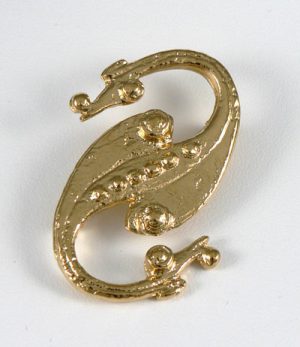
Dragonesque Brooch
£32.502nd century AD. The bronze original was found at South Shields. Dragonesque, so named from the monster head at each end, is of unusual British form being wrought with rivet decoration. Museum of Antiquities, Newcastle. Length 45mm
-
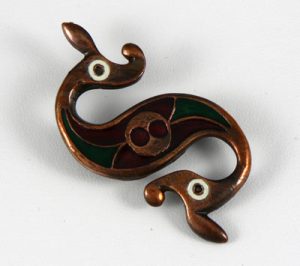
Dragonesque Brooch
£37.502nd century AD. The bronze and enamel original is a fine example of the double headed ‘dragon’ brooch. This was found at Milking Gap, Hadrian’s Wall. Bronze finish. Newcastle Museum of Antiquities. Length 52mm
-
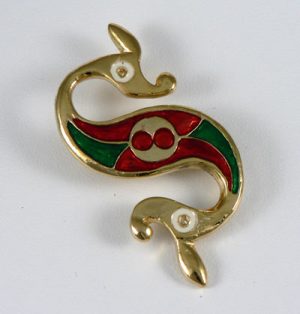
Dragonesque Brooch
£32.272nd century AD. The bronze and enamel original is a fine example of the double headed ‘dragon’ brooch. This was found at Milking Gap, Hadrian’s Wall. Gilded finish.Newcastle Museum of Antiquities. Length 52mm
-
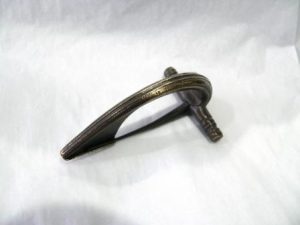
Roman Curve brooch
£75.00Very graceful curved brooch represenative of the fine work of this period. Early 2nd century AD. Length 65mm
-
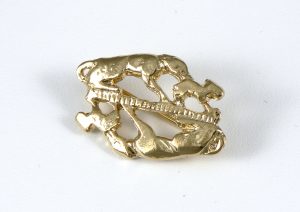
Roman Dog and Rabbit brooch
£23.42The bronze original depicts dogs chasing rabbits. Similar small animal brooches were found throughout the Empire during this period. 1st to 4th century AD.Ashmolean Museum, Oxford. Length 35mm.
-
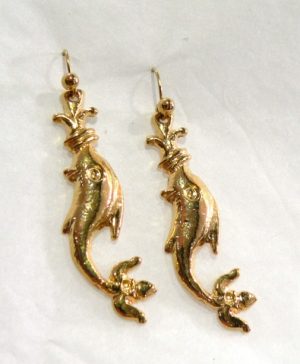
Roman Dolphin Earrings
£29.50The bronze original was found at the Caerleon Amphitheatre and can now be seen at the Roman Legionary Museum, Caerleon, South Wales. Reproduced as Earrings. 2nd – 3rd century AD. Length 26mm.
-
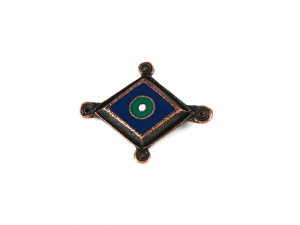
Roman Lozenge Brooch
£29.85The bronze original is decorated with blue and green enamel. It is of lozenge form with tooled circular projections at the corners. It was found at Bungay, Suffolk. 2nd century AD.Ipswich Museum, Suffolk.Length 47mm.
-
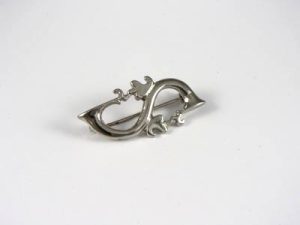
Roman Silver Brooch
£27.50Roman Silver Brooch. 2nd century AD. he original was found at Binchester Roman Fort. It was probably made in Germany during the second century AD. Bowes Museum, Co. Durham. Length 40mm
-
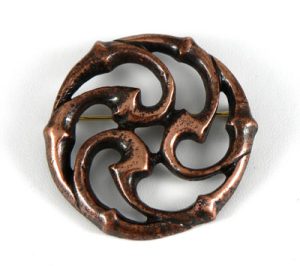
Roman Triskele Brooch
£32.85An elaborate series of trumpet scrolls producing a flowing circular design. The bronze original was found in the Roman city of Aventicum in Avenches, Switzerland. Diameter 48mm
-
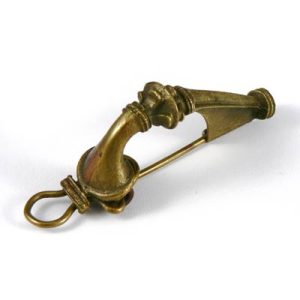
Roman Trumpet Brooch
£79.532nd century AD. Typical of the masculine type of brooch worn to hold the cloak at the shoulder. Excavated from Walbrook, London in 1950. The original is in the Museum of London. Height 71mm
-
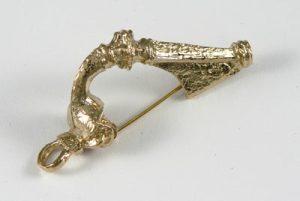
Roman Trumpet Brooch
£29.992nd century AD. The gilded bronze (ormolu) original was excavated at Vindolanda Vicus, a large Roman settlement on Hadrian’s Wall, Northumberland. Length 61mm
-
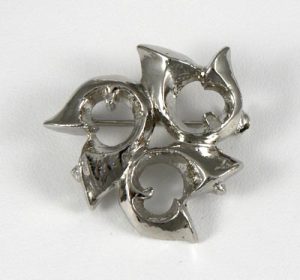
Roman Trumpet Scroll Brooch
£26.272nd century AD. This brooch is formed by concentric trumpet scroll shapes. The original of tinned bronze was found at Usk, Gwent and is now in the Roman Legionary Museum, South Wales. White metal plated finish. Width 33mm
-
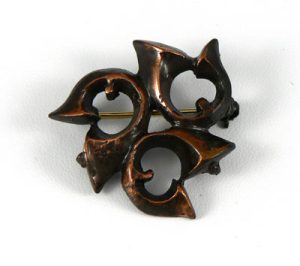
Roman Trumpet Scroll Brooch
£29.702nd century AD. This brooch is formed by concentric trumpet scroll shapes. The original of tinned bronze was found at Usk, Gwent and is now in the Roman Legionary Museum, South Wales. Bronze finish. Width 33mm
-
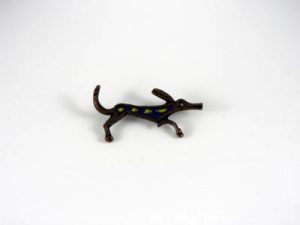
Romano British Brooch
£33.00British Brooch. 2nd century AD. The original is a bronze plate brooch in the form of a hunting hound decorated with blue and yellow enamel. Verulamium Museum, St. Albans, Hertfordshire. Length 40mm
-
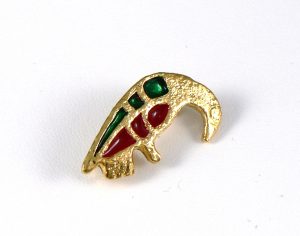
Romano-British Bird brooch
£33.00The bronze original is in the form of a bird decorated with red and blue enamel. It was found at Sixpenny-Handley, Dorset. 2nd century AD. Gussage and District Museum, Woodcutts, Dorset. Height 28mm.
-
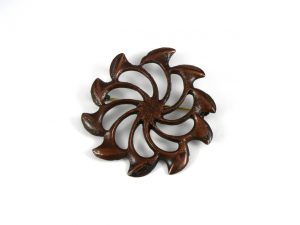
Romano-British Bronze Mount (Bronze finish)
£33.50Romano-British Bronze Mount. 150-250 AD. The original Bronze openwork mount, worn as a belt fitting, was found at Piercebridge Roman Fort, Co. Durham. The pattern is unusual and consists of a whirligig formed of trumpet shapes. Bronze finish. The Bowes Museum, Co. Durham. Diameter 48mm
-
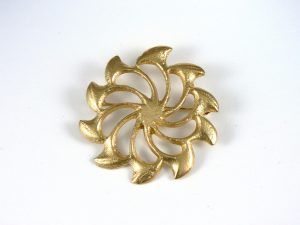
Romano-British Bronze Mount (gilt)
£31.50Romano-British Bronze Mount. 150-250 AD. The original Bronze openwork mount, worn as a belt fitting, was found at Piercebridge Roman Fort, Co. Durham. The pattern is unusual and consists of a whirligig formed of trumpet shapes. Gilt finish. The Bowes Museum, Co. Durham. Diameter 48mm
-
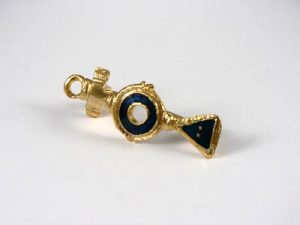
Romano-British Brooch
£31.99Romano-British Brooch. 2nd century AD. The bronze and enamel original was found on Down Farm, Gussage St. Michael, Dorset. Gussage and District Museum, Woodcutts, Dorset. Height 42mm
-
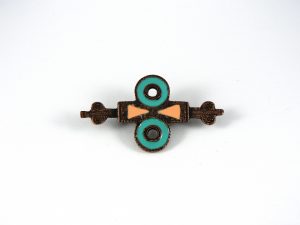
Romano-British Brooch
£35.50The original is a bronze plate brooch with blue enamel roundel and orange enamel triangle decoration. 2nd century AD. Verulamium Museum, St. Albans, Hertfordshire. Length 45mm.
-
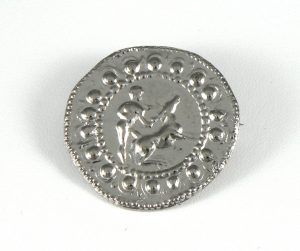
Romano-British Disc Brooch
£31.70The tinned bronze original from circa 90 – 97 AD is embossed with a Hunter and Stag motif and was probably sewn on to a textile garment. Excavated at Vindolanda, Hadrian's Wall, Northumberland. Diameter 33mm.
-
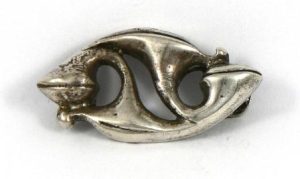
Romano-British Dress ornament silver brooch
£295.00Romano-British Dress ornament silver brooch. The bronze original was excavated in Colchester. Colchester and Essex Museum. Width 38mm
-
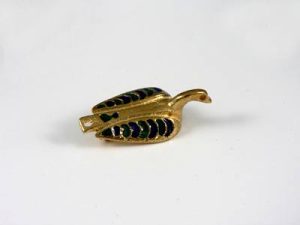
Romano-British Enamelled Brooch
£28.75Romano-British Enamelled Brooch. 2nd century AD. The bronze original with enamelled wings was found in the Roman aqueduct, Lincoln in 1952. City Museum, Lincoln. Length 38mm
-
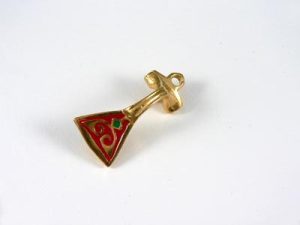
Romano-British Fantail Fibula
£30.95Romano-British Fantail Fibula. 2nd century AD. The bronze and enamel original was excavated at Vindolanda, Hadrian's Wall, Northumberland, where the original may be seen. Brooch with red enamel. Height 38mm
-
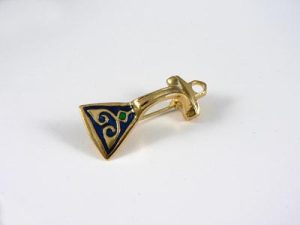
Romano-British Fantail Fibula
£30.95Romano-British Fantail Fibula. 2nd century AD. The bronze and enamel original was excavated at Vindolanda, Hadrian's Wall, Northumberland, where the original may be seen. Brooch with blue enamel. Height 38mm
-
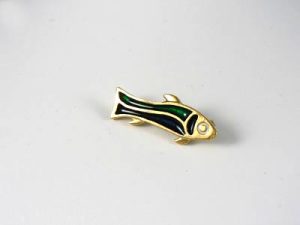
Romano-British Fish Brooch
£32.00Romano-British Fish Brooch. 2nd century AD. The bronze and enamel original is from a Romano-British shrine at Findon, Sussex. Worthing Museum, Sussex. Length 33mm
-
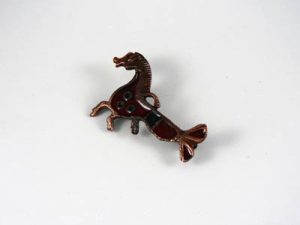
Romano-British Hippocamp Brooch
£34.50Romano-British Hippocamp Brooch. c 2-3rd century AD. The bronze original depicts a 'Hippocamp', a mythical creature with head and forelegs of a horse, the tail of a fish and the wings of a bird, which pulled the chariot of Poseidon across the Heavens. Ashmolean Museum, Oxford, England. Length 41mm
-
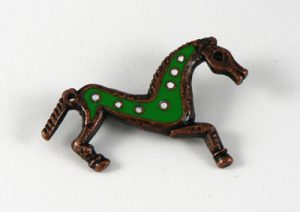
Romano-British Horse Brooch
£31.952nd century AD. The original is a bronze plate brooch of a galloping horse. The body and neck are inlaid with green enamel dappled with white spots. Found in a house in Roman Verulamium, it may be seen in the Verulamium Museum, St,. Albans. Length 44mm
-
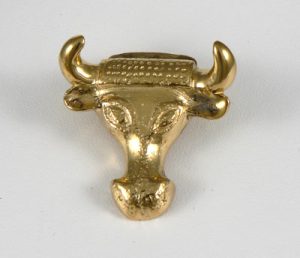
Romano-British Ox-head Escutcheon Brooch
£29.751st – 2nd century AD. The bronze original is one of a pair that would have decorated the handle attachments of a stave – built bucket. Found in Dinorben Hill Fort, Abergele, North Wales. May be seen in the National Museum of Wales. Width 34mm
-
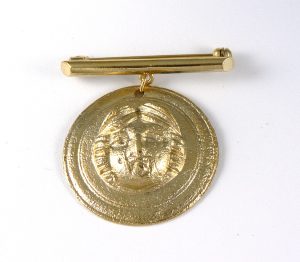
Romano-British Phaelera
£27.00The bronze original is a badge of distinction given to private soldiers and worn on the breast.2nd century. Gilded English Pewter. Diameter 38mm.

